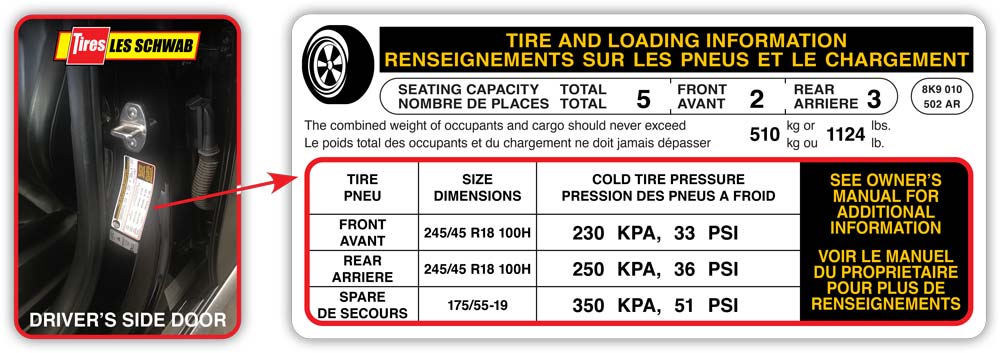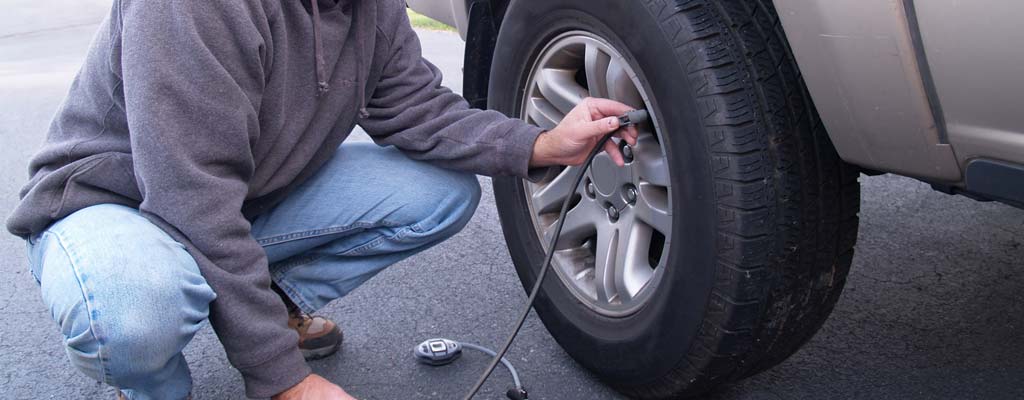How to Put Air in Your Tires
When you have the correct air pressure in your tires, it can improve fuel efficiency and safety. According to the National Highway Traffic Safety Administration (NHTSA), under-inflated tires can reduce your MPG (Mile Per Gallon) as well as affect handling, stopping, and impact-crash avoidance systems. To avoid these issues and keep your tires properly inflated, stop by Les Schwab for a free monthly air check. Schedule your appointment now.
How Do You Know How Much Air to Put in Your Tires
First, the correct pressure or PSI (Pounds Per Square Inch) of air inside your tires is not printed on the side of the tire. That is the maximum (cold) pressure that should not be exceeded, which can be very different from your vehicle’s recommended tire pressure.
The recommended tire pressure for your vehicle (and spare tire) is located in your owner’s manual or on the driver’s side door sticker. In many cases, it will list the pressure for both the front and back wheels when cold (first thing in the morning or before the vehicle has been driven).

How to Put Air in Your Tires
Whether you’re at home or at the gas station, adding air to your tires can be quick and easy. Look for an air compressor at your local gas station just beyond the pump lanes. It may require a few quarters to run. At home, you’ll need an air compressor. In both cases, you’ll need a tire pressure gauge.
Check your tire pressure. It’s important to complete this step in the morning or when the tires are cold. This will give you an accurate reading. To check the pressure in each tire, use a tire pressure gauge. These often look like a metallic pencil with a sliding measuring device on one end and a tire valve connection on the other.

- Park your car in the right place. Whether you’re at a gas station or home, be sure you can safely reach all four tires with the air hose.
- Remove the tire valve cap. Put the cap in your pocket so you don’t lose it.
- Place the compressor fitting firmly on the tire valve stem. Then begin to inflate your tire. You’ll hear air going into the tire. If you hear or feel air coming out, readjust the connection between the air nozzle and the valve stem on the tire.
- Add air for a few seconds. Keep in mind that not all air compressors inflate at the same rate. You’ll want to inflate and check your tire pressure often. Add air as needed. To remove air, quickly push in the center pin located inside your tire valve.
- Replace the valve cap. This helps keep more air in your tires for a longer period of time, and can keep road debris (dirt and more) from getting into the valve.
Les Schwab Tip: If you don’t have access to an air compressor or you’re not near a gas station, a bicycle pump might work in an emergency. Just be warned, it will take a lot of pumping and could ruin the bicycle pump.
Check Your Tire Pressure Monthly
Your tires can lose one pound of pressure per month on average. Over time, those small reductions in pressure can really add up. Anytime you’re out and about, pull into your local Les Schwab and we’ll check and inflate your tires for free.
Can You Drive on a Tire with Low Air?
The short answer is, sometimes. For example, releasing some pressure out of your tires can give you more grip in deep snow. However, driving with low air pressure isn’t encouraged and could cause irreparable damage to the tires or even failure.
What happens if you get a flat and can’t immediately fill your tires with air? That’s when it’s a good idea to change to your spare and get to Les Schwab as soon as possible. If you drive a vehicle with run-flat tires, they are designed to give you some time to get to Les Schwab if you get a flat or experience a slight reduction in air pressure.
Let Les Schwab Put Air in Your Tires
Pull into any Les Schwab location and our pros will perform a free air check and inflate your tires to the proper pressure. It’s just one of the many safety-minded services we’re proud to offer you and your family.
